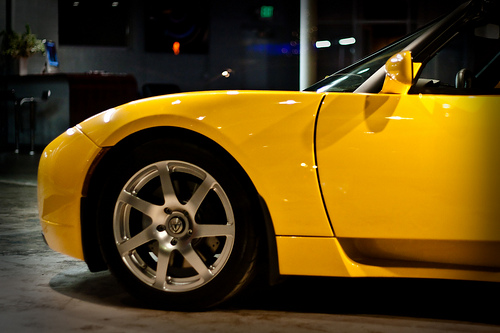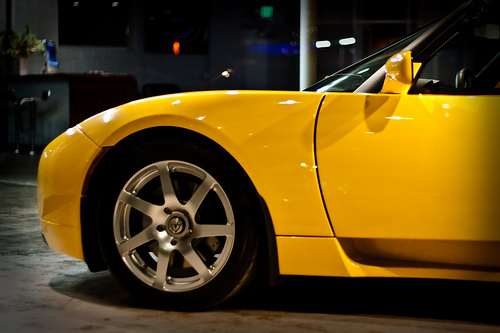When Tesla Motors opened its new showroom in Boulder, it did so in style. Hosting an invitation-only party, the automaker brought out a lively group of local politicians, environmentalists and entrepreneurs for a night of martinis, music and test-drives of the Tesla Roadster.
 A Tesla Roadster on display at the electric vehicle maker’s new store in Boulder, Colorado.Eric Magnuson via FlickrThe much talked about, all-electric, luxury sports car has received as much attention for its price tag as anything else. At more than $100,000, few people are likely to buy a Roadster. But with a temporary Colorado tax-break reducing the price to $67,800, surely someone in affluent Boulder will snag one. So why not throw a blowout party, invite a bunch of friends, and put the car on display for all to see?
A Tesla Roadster on display at the electric vehicle maker’s new store in Boulder, Colorado.Eric Magnuson via FlickrThe much talked about, all-electric, luxury sports car has received as much attention for its price tag as anything else. At more than $100,000, few people are likely to buy a Roadster. But with a temporary Colorado tax-break reducing the price to $67,800, surely someone in affluent Boulder will snag one. So why not throw a blowout party, invite a bunch of friends, and put the car on display for all to see?
But the Roadster is more than just an expensive car. Its sleek contours and luxury styling are enough to turn anyone into a car fanatic. Well before the party started, invited guests and curious onlookers had gathered outside the building, taking photos with their cell phones as traffic slowed along the west end of Pearl Street. It is a beautiful car, yes, but its performance — demonstrated in an all too brief test-drive up Boulder Canyon — is even more impressive. (Check out a video from Grist’s own Tesla ride.)
Inside the showroom, there was a certain zeal running through the conversations of the crowd. Like family members around a newborn’s crib, guests hovered over this car, taking photos and clinking cocktail glasses. To be sure, this was a party. But it was also something else. It was a night for the optimist, an opportunity to be there at the beginning of something new and exciting-something world-changing.
Born to be wired
Still in its infancy, the electric car has a future that is both promising and uncertain. It is often cited as an antidote to U.S. dependence on foreign oil, and for good reason — a Pacific Northwest National Laboratory study claims that if 73 percent of the country’s light-duty vehicle fleet were electrified, oil consumption would fall by 6.2 million barrels a day. That would eliminate nearly 53 percent of our current oil imports.
It’s an alluring goal, but 73 percent is a big, distant number. President Obama has called for 1 million electric cars on the road by 2015, and that’s only 0.5 percent of the entire U.S. fleet. The electric car has a ways to go.
But with consumer demand uncertain, automakers are treading lightly. Though most major companies plan to manufacture plug-ins during the next few years, with list prices substantially lower than the Tesla’s, initial production rates will be meager. Chevrolet, for instance, has revised plans to release 60,000 units of the highly anticipated Volt, cutting back to a conservative 10,000 units.
Demand is nearly impossible to predict. A product or technology can stagnate for months-years even-and then take off, spreading out into the marketplace. With electric vehicles, there’s legitimate concern over the likely demand. But, in the meantime, we can work on dismantling the obstacles most likely to plague this technology. Much of that work can be done on the ground, at the city level.
Home is where the start is
Electric vehicles aren’t likely to pour into car lots next year. Our current economy will make sure of that. Nevertheless, many cities can position themselves to benefit from the technology. In doing so, they very well may play the most vital role in the success of these cars.
One such city, Denver, has already begun this work.
As one of several partner cities on Project Get Ready — a Rocky Mountain Institute initiative that convenes city leaders and plug-in champions nationwide — Denver has assembled working groups to facilitate the move to electrified cars. By targeting concerns and perceived inconveniences related to the electric vehicle, these groups may achieve more than any car commercial, marketing campaign, or glitzy cocktail party could ever hope for.
The City and County of Denver has selected nearly 100 sites around the city at which public charging units could be installed. This will offer the public the first tangible look at how electric cars will operate in the city while assuaging fears over their driving ranges.
There’s a strong argument for this approach. Although electric vehicles have garnered considerable attention over the years, many people still lack an understanding of how the technology will work in the cities and on the highways. Charging units, placed in key locations, will serve as a visual reminder that the technology is real and the infrastructure is in place.
Smart Grid City
In nearby Boulder, one of the nation’s largest electrical utilities, Xcel Energy, is busy installing new smart meters in selected homes and businesses throughout the city. The first project of its size, Smart Grid City will demonstrate the benefits of advanced energy software and real-time information.
If Xcel’s recent request to the Colorado Public Utilities Commission for a peak-pricing program is approved, the company will offer consumers a financial incentive to draw energy at off-peak hours. An electric vehicle, for instance, could be plugged in at 9:00 pm, when peak power usage has leveled off, therefore promoting the use of night-time wind energy. The smart meters used in Xcel’s program may end up playing an important enabling role in the use of electric cars since utility rates will play an intrinsic role in what time people decide to charge their vehicles.
A Bright Future
Boulder and Denver’s civic and government leaders, research institutions, and entrepreneurs are building a home for the electric car. Rather than waiting for the car to arrive, these entities are plug-in-proofing their cities and demonstrating a belief in the potential for vehicle electrification.
With all the money and time going into this effort, the electric car will have a better chance of widespread adoption and we’ll be one step closer to energy independence. If it takes a party to sell some cars and get the word out, so be it. That’s a future that calls for celebration.



